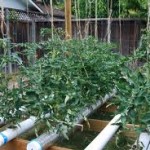 Most homesteaders are typically the most frugal people when it comes to their resources and land. If you ask most people who homestead, they will likely give an answer that shows being frugal is simply part of a homesteading lifestyle. It’s called, being resourceful and also being a good steward of the land.
Most homesteaders are typically the most frugal people when it comes to their resources and land. If you ask most people who homestead, they will likely give an answer that shows being frugal is simply part of a homesteading lifestyle. It’s called, being resourceful and also being a good steward of the land.
But, not all homesteads are on sprawling farms. As populations grow and cities take over more rural areas, more-and-more home farms are springing up on small plots of land. That increases the need to be resourceful with the land.
Let’s consider a scenario where property may be limited, but you still have the need for growing your own food.
The reality is, you may find yourself in a situation where you do not have room or even soil to grow plants. What do you do? Disaster has struck and you believe the soil is possibly contaminated, but it is essential that you have the ability to grow your own food. Fact is: You can grow your own food without soil.
The things you will need however are a growing medium, such as coconut grass, water, plant nutrients, two small water pumps and some type of water trough. Additionally you will need, what is generally referred to, as chicken wire. The wire should be small enough gauge where you can mold it into holders for the coconut grass. You will essentially be making small wire baskets to hold the seeds and grass.
The trough can be guttering that is used on structures or plastic water pipe such as polyvinyl chloride or PVC. The PVC can be cut down the middle to give you two halves. Use larger pipe, up to eight inches in diameter if you plan to grow large root vegetables. It is also recommended you split the pipe if growing root vegetables. You can grow inside or outside, but remember certain plants require pollination by bees. However, if you must grow inside you can pollinate by hand using a small camel hair paintbrush.
You start with a water reservoir. The reservoir at one end of the tubing will be to feed the plants; you must also have a collection reservoir to contain the circulated water. If you have decided not to split the pipe, you can cut holes in the pipe and insert the wire baskets. The idea behind hydroponics is keeping the growing medium, which in this case is coconut grass, wet with nutrient rich water. The screen is fashioned over the trough and at one-foot intervals, you will cut a hole in the screen and place the seedpod basket made from the wire, in the hole. The basket must be such that the grass is in the water stream. Simply bend the wire so it is attached to the screen covering the pipe. A quick review shows you have two pipes with a screen covering them, and at one-foot intervals, you have inserted wire baskets with coconut grass.
The reservoir that feeds the plant trough will need a small pump and tubing. The pump will push the water through the trough, flowing through the grass. The grass collects the nutrient rich water supplying the seed and eventually the plant itself with nutrients. Once established the roots can grow into the trough allowing the water to run over them. The roots will collect what is needed to feed the plant. Place 3 seeds in each basket of coconut grass. Once each plant has grown a third leaf, cull out the weaker looking ones. Virtually any vegetable can be grown this way to include potatoes, carrots, turnips and other root vegetables. Tomatoes, peppers, squash and cucumbers can be grown, as well.
The pump pushes the water along the trough. In most cases, it is acceptable to have a continual stream. The water must flow into a collection trough or be routed by tubing back into the reservoir that feeds the plants. You can insert a pump into the collection tank and pump it back to the feeding tank, as well. The nutrients will deplete themselves overtime so it is important to replenish as needed with water-soluble fertilizer. Know how many gallons are in the feeding tank so the proper ratio of fertilizer to water can be achieved. Purchase a water test kit at any garden supply store and test your water for nutrients. With some experimentation you will soon learn how often to add nutrients.
If you grow in a green house or even outside sunlight will not be a problem, if inside you will need adequate lighting. Grow lights or fluorescent lights are acceptable. You need a minimum of 16 hours a day of lighting if growing inside a structure.
Start and stop at the same times every day. You will need a support structure for certain plants such as cucumbers or tomatoes. This can be accomplished by running string down each side of the troughs. You will need to elevate the support structure, as the plants develop. Also, as the plants develop and the roots become much longer, you will have to maintain the correct water level. The plants will absorb much more water and fertilizer when grown this way, thus producing fast growing healthy plants.
If you are interested in Alternative Growing Methods, there are great resources in the upcoming issue of PREPARE Magazine. Get a free one-year subscription


